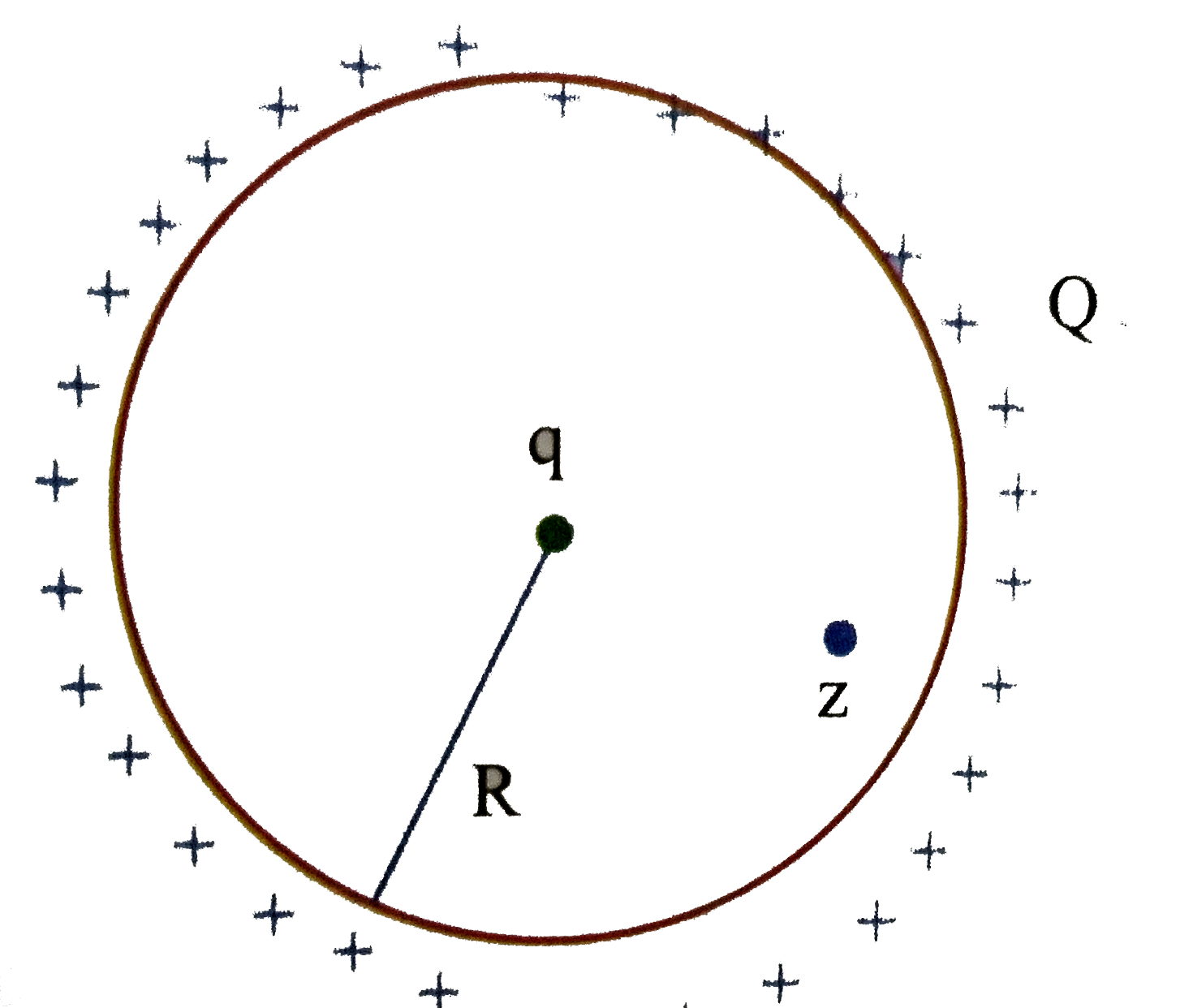Two identical thin ring, each of radius R meters, are coaxially placed a distance R metres apart. If Q1 coulomb, and Q2 coulomb, are repectively the charges uniformly spread on the two rings, the work done in moving a charge q from the centre of one ring to that of the other is
(a) zero
(b) q(Q1−Q2)(√2−1)(4√2πε0R)
(c) q√2(Q1+Q2)(4πε0R)
(d) q(Q1+Q2)(√2+1)(4√2πε0R)
The correct Answer is:B
To solve the problem of finding the work done in moving a charge q from the center of one ring to the center of the other ring, we can follow these steps:
Step 1: Understand the Configuration
We have two identical thin rings, each with radius R, placed coaxially at a distance R apart. The charges Q1 and Q2 are uniformly distributed on the two rings.
Step 2: Calculate the Electric Field at the Center of the Rings
The electric field E at the center of a charged ring due to its own charge is zero because of symmetry. However, we need to calculate the electric field at the center of one ring due to the charge on the other ring.
The distance from the center of one ring to the center of the other ring is R. The electric field E at the center of ring 1 due to ring 2 can be calculated using the formula:
E=14πϵ0⋅Q2R2
where ϵ0 is the permittivity of free space.
Step 3: Calculate the Work Done
The work done W in moving a charge q in an electric field E is given by:
W=q⋅E⋅d
where d is the distance moved in the direction of the electric field. In this case, d=R.
Substituting the expression for E:
W=q⋅(14πϵ0⋅Q2R2)⋅R
This simplifies to:
W=q⋅Q24πϵ0R
Final Result
Thus, the work done in moving the charge q from the center of one ring to the center of the other ring is:
W=q⋅Q24πϵ0R
We have two identical thin rings, each with radius R, placed coaxially at a distance R apart. The charges Q1 and Q2 are uniformly distributed on the two rings.
The electric field E at the center of a charged ring due to its own charge is zero because of symmetry. However, we need to calculate the electric field at the center of one ring due to the charge on the other ring.
E=14πϵ0⋅Q2R2
where ϵ0 is the permittivity of free space.
The work done W in moving a charge q in an electric field E is given by:
W=q⋅E⋅d
where d is the distance moved in the direction of the electric field. In this case, d=R.
W=q⋅(14πϵ0⋅Q2R2)⋅R
This simplifies to:
W=q⋅Q24πϵ0R
Thus, the work done in moving the charge q from the center of one ring to the center of the other ring is:
W=q⋅Q24πϵ0R
Topper's Solved these Questions
- ELECTROSTATICSBOOK - SUNIL BATRA (41 YEARS IITJEE PHYSICS)CHAPTER - ELECTROSTATICSEXERCISE - Subjective Problems
2 Videos
- ELECTROSTATICSBOOK - SUNIL BATRA (41 YEARS IITJEE PHYSICS)CHAPTER - ELECTROSTATICSEXERCISE - Comprehension Based Questions
2 Videos
- ELECTROMAGNETIC INDUCTION AND ALTERNATING CURRENTBOOK - SUNIL BATRA (41 YEARS IITJEE PHYSICS)CHAPTER - ELECTROMAGNETIC INDUCTION AND ALTERNATING CURRENTEXERCISE - JEE Main And Advanced
107 Videos
- MODERN PHYSICSBOOK - SUNIL BATRA (41 YEARS IITJEE PHYSICS)CHAPTER - MODERN PHYSICSEXERCISE - MCQ (One Correct Answer
1 Videos
Similar Questions
Two identical thin rings, each of radius R, are coaxially placed a distance R apart. Q1 and Q2 are respectively the charges uniformly spread on the two rings. The work done in moving a charge q fróm the centre of one ring to that of the other is (√x−y)q(Q2−Q1)4√2πɛ0R. Find (x−y)
View SolutionPotential on the axis of ring of radius 3R and at distance 4R from centre of ring is (charge on the ring is Q )
View Solution
Knowledge Check
Two identical thin ring each of radius R are co-axially placed at a distance R. If the ring have a uniform mass distribution and each has mass m1 and m2 respectively, then the work done in moving a mass m from the centre of one ring to that of the other is :
AzeroBGm(m1−m2)(√2−1)√2RCGm√2(m1+m2)RDGm1m(√2+1)m2RTwo identical thin rings each of radius R are coaxially placed at a distance R. If the rings have a uniform mass distribution and each has masses 2m and 4m respectively, then the work done in moving a mass m from centre of one ring to that of the other is
AzeroB√2Gm2R(1−√2)CGm2√2R(√2−1)DGm2√2RTwo identicaln thin rings each of radius 10 cm carrying charges 10 C and 5 C are coaxially placed at a distance 10 cm apart. The work done in moving a charge q from the centre of the first ring to that of the second is
Aq8πε0.[√2+1√2]Bq8πε0.[−√2+1√2]Cq4πε0.[√2+1√2]Dq4πε0.[√2−1√2]
Two identical rings PandQ of radius 0.1m are mounted coaxially at a distance 0.5m apart. The charges on the two rings are 2μCand4μC, respectively. The work done in transferring a charge of 5μC from the center of P to that of Q is.
View SolutionCharges q is uniformly distributed over a thin half ring of radius R. The electric field at the centre of the ring is
View SolutionA positive charge Q is uniformly distrubuted along a circular ring of radius R.a small test chage q is placed at the centre of the ring .The

View SolutionA charge Q is uniformly distributed only on the fourths portion of a ring of radius R. The elctric potential at centre of ring is
View SolutionTwo identical coaxial rings each of radius R are separated by a distance of √3R. They are uniformly charged with charges +Q and −Q respectively. The minimum kinetic energy with which a charged particle (charge +q) should be projected from the centre of the negatively charged ring along the axis of the rings such that it reaches the centre of the positively charged ring is
View Solution
